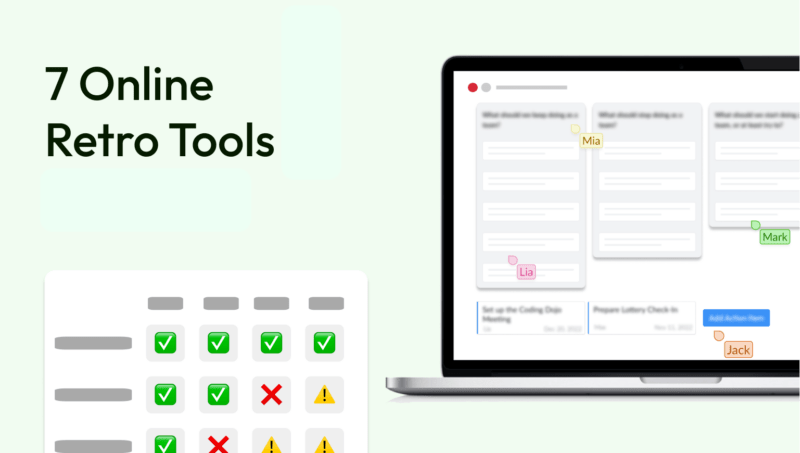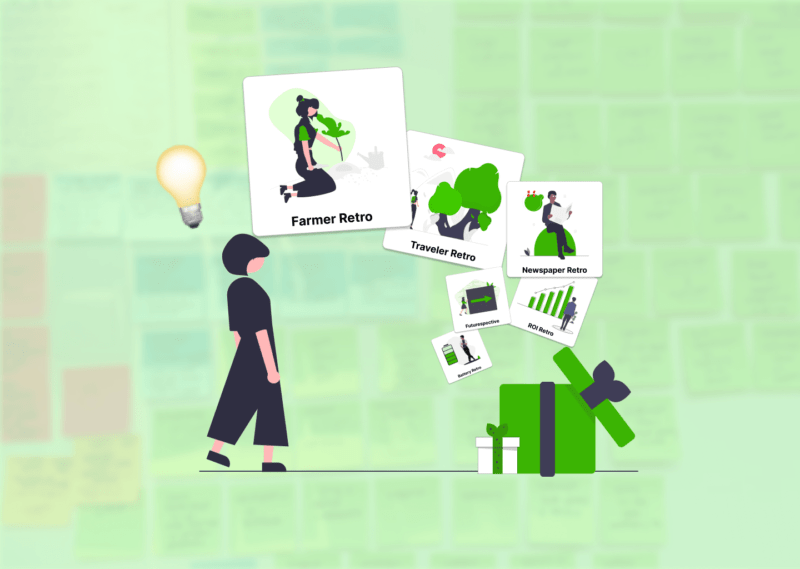Effective collaboration in teams is crucial for success, especially in the context of agile methods such as Scrum. Working Agreements play a crucial role in creating a clear framework for collaboration. And, of course, model working agreements can help to come up with good ideas here.
In this article, I've taken a closer look at the importance of working agreements in agile and remote teams and also evaluated how regular reviews and adjustments help to continuously improve a dynamic and productive team environment. Let's start with an introductory explanation of working agreements.
One more thing: As a manager, do you feel unsure about what systematic & successful people management looks like? Then I have something for you: Our free online people management training course.
Take a look and learn, for example, a trick on how you can increase team performance relatively easily by 10-20%. Feel free to have a look, you can get started right away 🙂 But back to the topic.
Agile Sample Working Agreements Scrum | Examples Templates
Agile Working Agreements: What are they?
"Working agreements refer to agreements or rules that are established within a team or organization to improve collaboration and promote a positive work environment. These agreements serve as a guide for the behaviour of team members and can help minimize misunderstandings, increase productivity and reduce conflict.
Typically, working agreements are drawn up at the beginning of a project or collaboration and accepted by all team members. These agreements can cover various aspects, including
Communication: Definition of communication channels, times and styles to promote effective and transparent communication.
Working hours: Clarification of working hours, breaks and availability to ensure a consistent work structure.
Responsibilities: Define the roles and tasks of each team member to create clarity about responsibilities.
Respect and cooperation: Agreement on respectful behavior, the promotion of teamwork and the resolution of conflicts in a constructive manner.
Working method: Definition of processes, methods and tools to be used in the team to ensure efficiency and consistency.
Feedback: Clarification of feedback mechanisms and culture in order to promote open and constructive feedback.
The purpose of working agreements is to create a common understanding and ensure that all team members work in the same way. These agreements can vary depending on the team and project and should be reviewed regularly and adapted as necessary.
So what could be concrete examples of working agreements? The following sample working agreements will help you to better understand the subject matter.
Agile Sample Working Agreements Scrum | Examples Templates
Agile Working Agreements Examples
Here are some examples or sample working agreements that can be established in a team or organization:
Respectful communication:
- We respect the opinions and ideas of all team members.
- Criticism is constructive and aims to improve cooperation.
- We listen attentively and give everyone the opportunity to express themselves.
Punctuality and availability:
- We adhere to agreed working hours and inform the team of any absences in good time.
- In urgent cases, we will inform the team about delays in good time.
Tasks and responsibilities:
- Each team member understands their roles and responsibilities.
- We divide tasks transparently and help each other when necessary.
Effective communication:
- We use clear and precise language.
- We share important information via the communication channel provided for this purpose.
Working methods and tools:
- We use jointly defined tools and methods for project work.
- Changes to tools or processes are discussed and agreed within the team.
Feedback culture:
- We regularly give constructive feedback and take time to reflect on it.
- Feedback is given on a factual and respectful level.
Personal responsibility:
- Each team member takes responsibility for their tasks and for achieving the team's goals.
- We actively look for solutions before we let problems escalate.
Confidentiality:
- Information marked as confidential will be respected and not shared without consent.
These examples or samples serve as a starting point. It is important that working agreements correspond to the specific needs and dynamics of the team. The agreements should be discussed openly and accepted by all team members.
For example, you may be working in a Scrum team. What would concrete examples of working agreements in Scrum look like?
Before I go into this, I would like to point out our working agreement or workshop and Health Check retrospective templates: In Echometer you can reflect Health Check items (quasi Working Agreements) in your agile retrospectives. You can take a look at it directly (without login) by clicking on the button below:
Note: This retrospective format asks for agreement with the given Health Check items on a scale.
- Appreciation: My colleagues appreciate my contribution to the team.
- Team Spirit: There is a trusting working atmosphere in our team.
- Transparency: Everyone in my team knows who is currently working on what.
- Recovery & Breaks: I have enough room for breaks in which I can draw new energy.
- Meeting culture: Our meetings are well structured, yet leave room for creativity and new ideas.
- Support: In my team, each team member passes on their individual knowledge and experience.
Agile Sample Working Agreements Scrum | Examples Templates
Agile Working Agreements Examples for Scrum Teams
In the Scrum context, working agreements can help to promote collaboration within the team and ensure that all members work effectively and efficiently. The following would be some concrete examples or samples of Working Agreements in a Scrum team:
Punctuality at Scrum events:
- All team members commit to showing up on time for Scrum events, including Sprint Planning, Daily Stand-up, Sprint Review and Sprint Retrospective.
Active participation in Scrum events:
- Each team member actively participates in Scrum events, shares progress, obstacles and looks for opportunities to collaborate.
Limitation of the work in progress (WIP):
- The team agrees on a maximum number of tasks that can be completed at the same time in order to avoid overload and to promote the completion of tasks.
Daily stand-up rules:
- The daily stand-up remains short and focused, with everyone only sharing relevant information about their work and any obstacles.
- Discussions that are not directly related to the daily stand-up are held outside the meeting.
Definition of "Done":
- The team has a clear and mutually accepted definition of "Done" for each task to ensure that completed tasks are of high quality and complete.
Responsibilities for obstacles:
- Team members commit to reporting obstacles immediately and actively contributing to the solution, if possible.
In addition to Scrum, there are other frameworks, such as the Scaled Agile Framework SAFe, which is used in scaled agile teams. What could examples or sample working agreements look like?
Before we go any further, here's a quick note. Ultimately, one of the main goals of work agreements is to improve your team's performance. But how do you actually achieve this holistically? I explain an important mental model to answer this question in part two of our free People Development Online Training course:
Agile Sample Working Agreements Scrum | Examples Templates
Agile Working Agreements Examples for SAFe (Scaled Agile Framework)
Here, too, there are sample working agreements that go in similar directions:
PI planning:
- We prepare ourselves well for SAFe Program Increment (PI) planning and bring all the relevant information with us.
- Everyone has the opportunity to share their point of view and we encourage an open discussion.
Continuous improvement:
- We are committed to continuous improvement and actively participate in SAFe and team retrospectives.
- Suggestions for improvement are documented and implemented in the next iterations.
Clear definition of Ready and Done:
- We have clear criteria for "Ready" (ready for processing) and "Done" (completed) at release train level.
- The definitions are regularly reviewed and updated as necessary.
Knowledge sharing and collaboration:
- We promote the exchange of knowledge between the SAFe teams within the ART and contribute to the shared knowledge base.
- Teams work closely together and support each other to achieve the PI goals.
Respect for roles and responsibilities:
- Each role in the SAFe framework is respected and the responsibilities of the individual roles are clearly defined.
- Conflicts or ambiguities regarding roles are resolved proactively.
These are a few examples or sample Working Agreements in SAFe. It is important that teams adapt the SAFe Working Agreements to their context and review them regularly to ensure that they continue to be effective.

Now that we've talked about Scrum and SAFe, what about working agreement examples in remote teams?
Agile Sample Working Agreements Scrum | Examples Templates
Working agreement examples for remote teams
Working agreements are particularly important for remote teams as they help to set clear expectations and optimize collaboration in a virtual environment. Here again is a small list of ideas and examples or sample working agreements in remote teams:
Communication rules:
- Definition of preferred communication channels (e.g. chat, video calls, e-mail).
- Clear expectations regarding the response time to messages.
Working hours and availability:
- Transparent definition of working hours and availability.
- Clarification of how and when breaks can be taken.
Status updates:
- Agreement on regular status updates to give team members insight into ongoing tasks.
- Use of tools to update the work status.
Meeting etiquette:
- Clear rules for participation in virtual meetings, including punctuality and active participation.
- Recording of meetings to support those who were unable to attend.
Documentation and knowledge exchange:
- Agreement on the documentation of decisions, discussions and measures taken.
- Use of shared document or knowledge platforms for easy collaboration.
Availability for spontaneous conversations:
- Clarity about when team members are available for spontaneous conversations and when they are not (e.g. through status displays).
Help and support:
- Open communication about the need for help and support services.
- Establishment of a channel for questions and help within the team.
Confidentiality and data protection:
- Agreement on the respectful handling of confidential information and data protection guidelines.
Breaks and relaxation:
- Encourage breaks to recover and avoid overwork.
- Encourage the use of absence notifications during breaks or vacations.
These examples or templates are designed to address the specific challenges of remote working and facilitate collaboration in a distributed team. It is important that these agreements are drawn up jointly, because only then will the team really take them to heart!
Speaking of –, how would it actually work to define your own working agreements? There are templates for this!

Agile Sample Working Agreements Scrum | Examples Templates
Working Agreement Template
A working agreement template is a predefined format or template that serves as a starting point for creating working agreements in a team or organization. It helps to structure the processes and ensure that important aspects of collaboration are covered. Here are some elements that could be included in a working agreement template:
Headline:
- A clear heading indicating that this is a working agreement. For example: "Team Working Agreement" or "Scrum Team Working Agreement".
Introduction:
- A short introduction explaining the purpose of the Working Agreement and emphasizing why it is important.
Date and version:
- A section for the date the Working Agreement was created or updated and the version number to ensure that all team members are using the latest version.
Responsible parties:
- A list of responsible parties, including all team members and possibly also the team leader or Scrum Master.
The Working Agreement itself:
- This is where the core is to be found, the concrete action for the team.
Continuous improvement:
- An area that underlines the fact that the Working Agreement could well be adapted again in the future – at the beginning it would therefore possibly still be empty.
Signatures:
- Space for the signatures of all team members to confirm that they have read, understood and accepted the Working Agreement.
Such a template can serve as a starting point for discussions within the team and promotes the active participation of all members in the definition of their working agreements.
However, the focus of this template would be on the documentation of the Working Agreements. But how do you draft them? An open method for this could be the "Team Commitments" questions. Here, 3 sentences are given that aim to filter out existing behaviors from the team in order to define concrete working agreements based on them. The latter would probably only happen in a second step.
Below you will find the sentences for the Working Agreement Template: The goal is that the team simply completes the sentences to understand which behaviors currently exist or which behaviors are desired. Part of the workshop also includes a simple Health Check survey at the beginning, which asks anonymously how "aligned" the team's understanding of good work actually is.
You can also conduct the workshop directly in our retrospective and team development tool Echometer by pressing the button.
Health Check Survey
As a team, we share a common understanding of what "good work" is.
Open Feedback Questions
Handling of contradictory priorities: ‘When I encounter contradictory priorities, I …’
Communication of blockers: ‘When I am stuck on a task, I announce this by …’
Navigation of conflicts: ‘When I notice a conflict start to build up in our team, I …’
Agile Sample Working Agreements Scrum | Examples Templates
Reflecting on working agreements in a one-to-one meeting
Many managers have regular one-to-one meetings with their employees. This meeting routine – alongside agile retrospectives (see below) – is of course also suitable for individually reflecting on working agreements.
The idea is that you pick out individual working agreements once every one or two months, for example, and make them part of your one-to-one meeting.
The exciting thing here is that it should of course be working agreements that are particularly relevant to the individual.
The following template gives you a few examples of statements that you can reflect on in a one-to-one meeting. You can even try them out directly in our 1-to-1 meeting tool Echometer by clicking on the green button.
⁉️ Agreements (agreement from 1-7) for personal development
- "My work tasks usually progress very quickly, even if external feedback is necessary."
- "If I observe suboptimal behavior, I know how I can constructively draw my colleagues' attention to it."
- "I receive constructive Feedback both to my work and to my personal development."
- "I see an attractive career path ahead of me in the company." #Growth
- "In the last few weeks, I have often been able to use my Strengths at work."
This is what this survey looks like in Echometer:
Admittedly: I am extending the term "working agreement" here to an area of work outside the team. But I am doing this deliberately because there is obviously also great potential in the individual development of employees.
If you are interested in good templates for 1-to-1 meetings, take a look here: Here you will find 129 one-to-one meeting (or appraisal interview) questions and Here are the 3 best one-on-one meeting tools in comparison – including Echometer of course.
Agile Sample Working Agreements Scrum | Examples Templates
Central: Continuous reminding & improving
Experience shows that working agreements can easily be forgotten in some document or on a poster on the wall after a few weeks of the project have passed. What can you do about it?
My suggestion:
- Put the Working Agreements regularly on the agenda of your agile retrospectives!
- Use (possibly anonymous) surveys to recall working agreements in a simple way.
The advantage of this method is that it creates even more exciting metrics for your continuous improvement – and there are even more positives:
Measurable metrics:
- Surveys can provide quantifiable metrics to measure the effectiveness of Working Agreements and also Agilen coaching and identify trends over time.
Integration into the workflow:
- The integration of surveys into the normal workflow enables the team to continuously deal with the Working Agreements without the need for special meetings.
Anonymity and openness:
- Surveys can provide anonymity, which may encourage team members to give honest feedback without worrying that their opinions will be identified.
In fact, the methodology of the Echometer tool is exactly as described: it combines agile Health Check surveys – on working agreements – with agile retrospectives, among other things. This approach makes agile coaching much more efficient and finally measurable. Echometer is regarded as one of the best retrospective software tools.
Echometer is a digital tool that helps agile team leads with agile retrospectives and team Health Checks. Whether remote, hybrid or on-site: it makes team coaching measurable and professionalizes your work while saving you a lot of work. Just take a look at our website to find out more: www.echometerapp.com.
"Working agreements too often end up in the dusty basement of an inefficient team - get them out of there, right in the middle of your retrospective!"
Christian Heidemeyer, Psychologist & Scrum Master
Agile Sample Working Agreements Scrum | Examples Templates
Conclusion - Agile Working Agreements in Scrum and beyond
I hope my thoughts on Working Agreements have shown that they are not just guidelines, but can be living instruments of team collaboration. Continuous reflection, integration of feedback and adaptation to changing conditions are crucial for the success of working agreements.
Finally, a note again: If you would like to try out how it feels to regularly reflect on working agreements in your retrospectives: You can start an agile retrospective below without logging in, in this case the "Keep, Stop, Start" workshop.
Alternatively, simply forward our website to the responsible colleagues: www.echometerapp.com.









